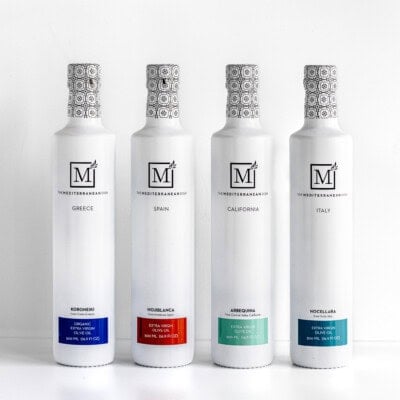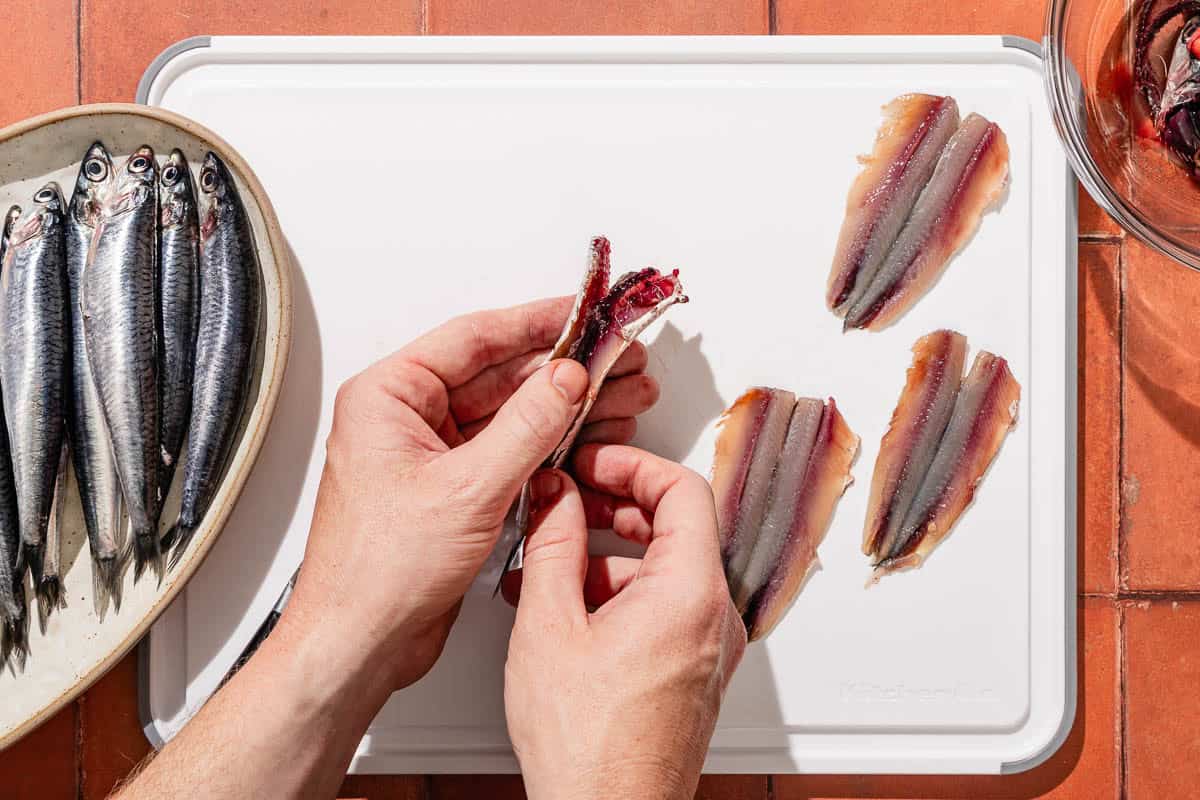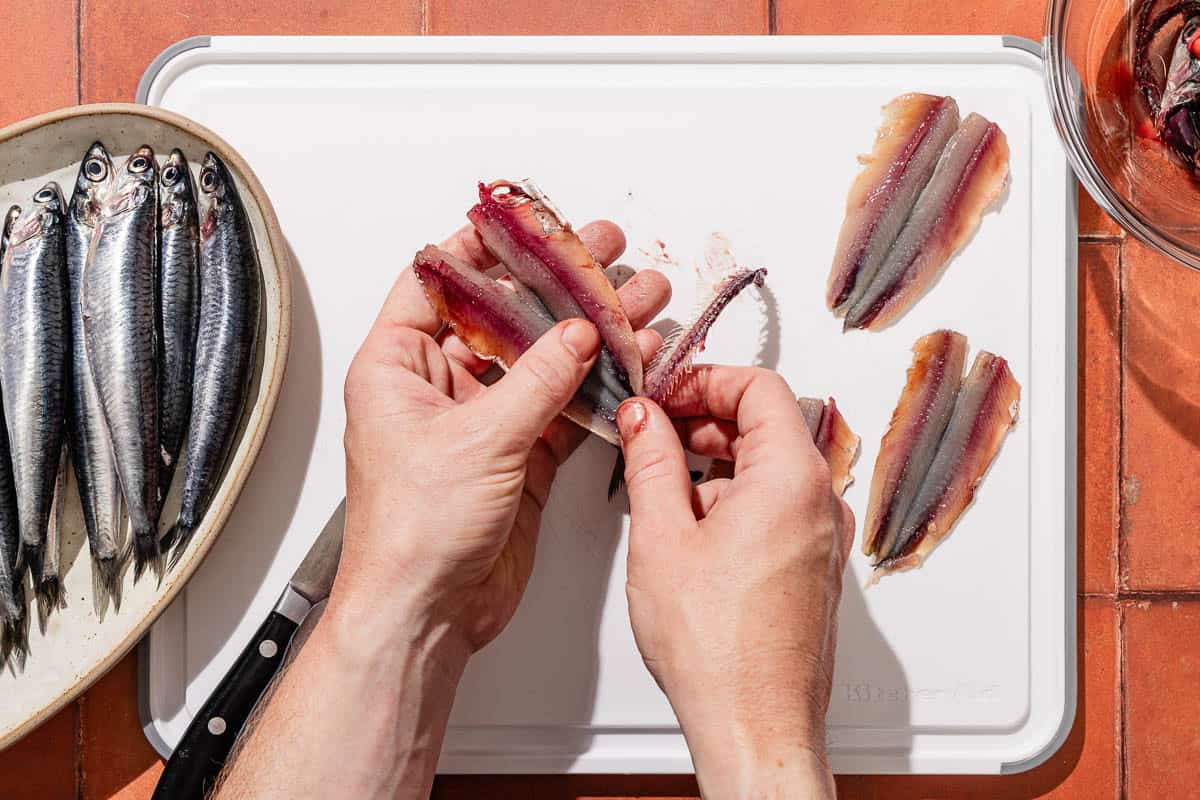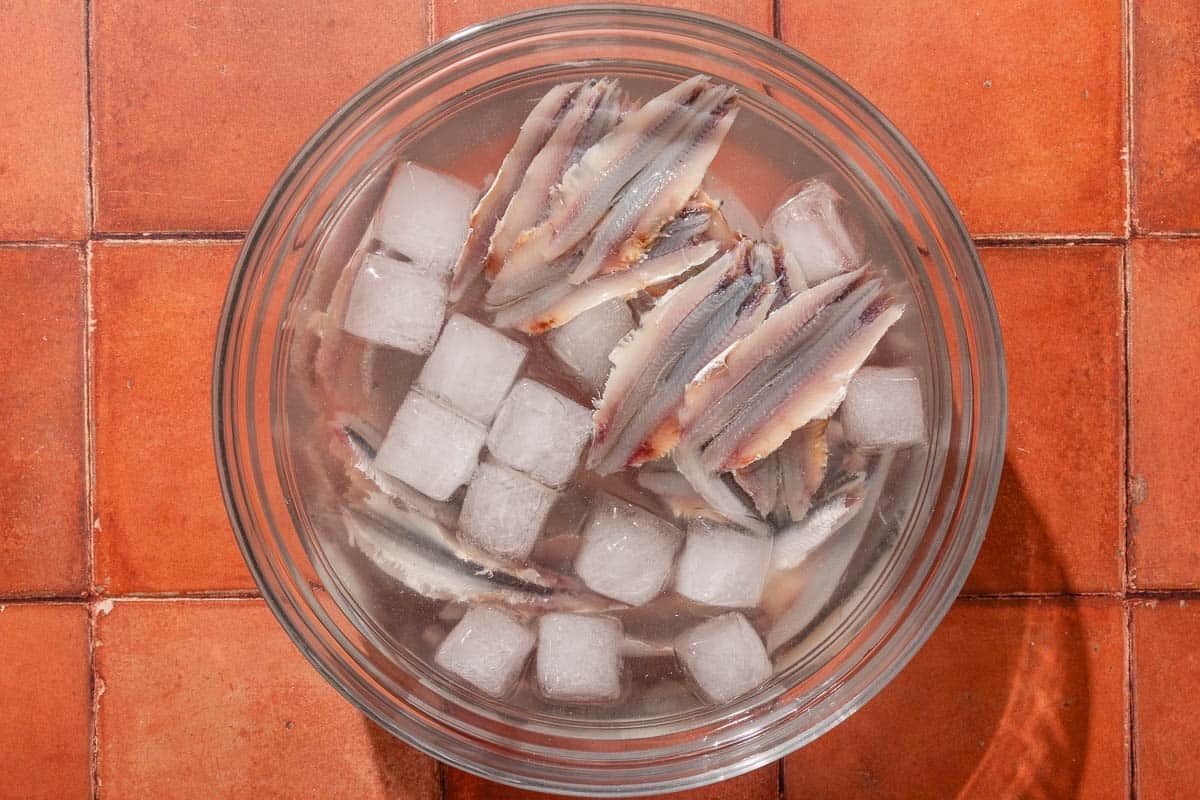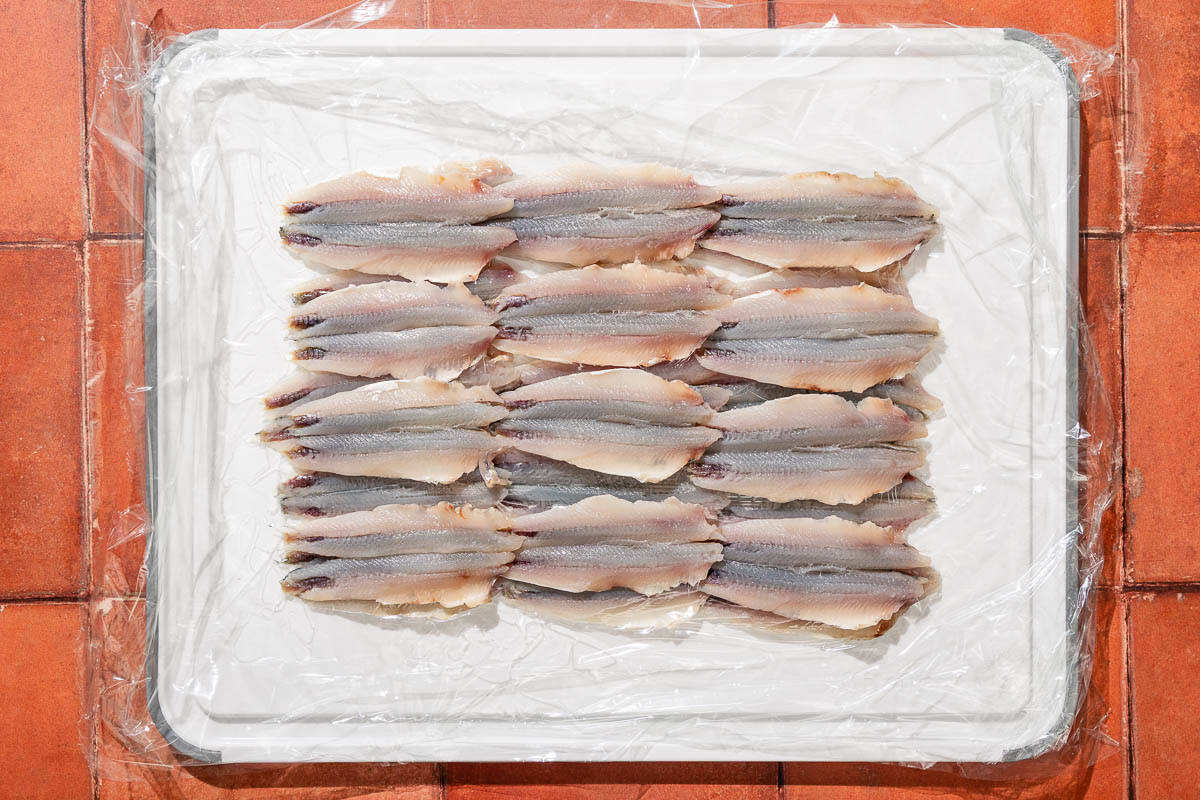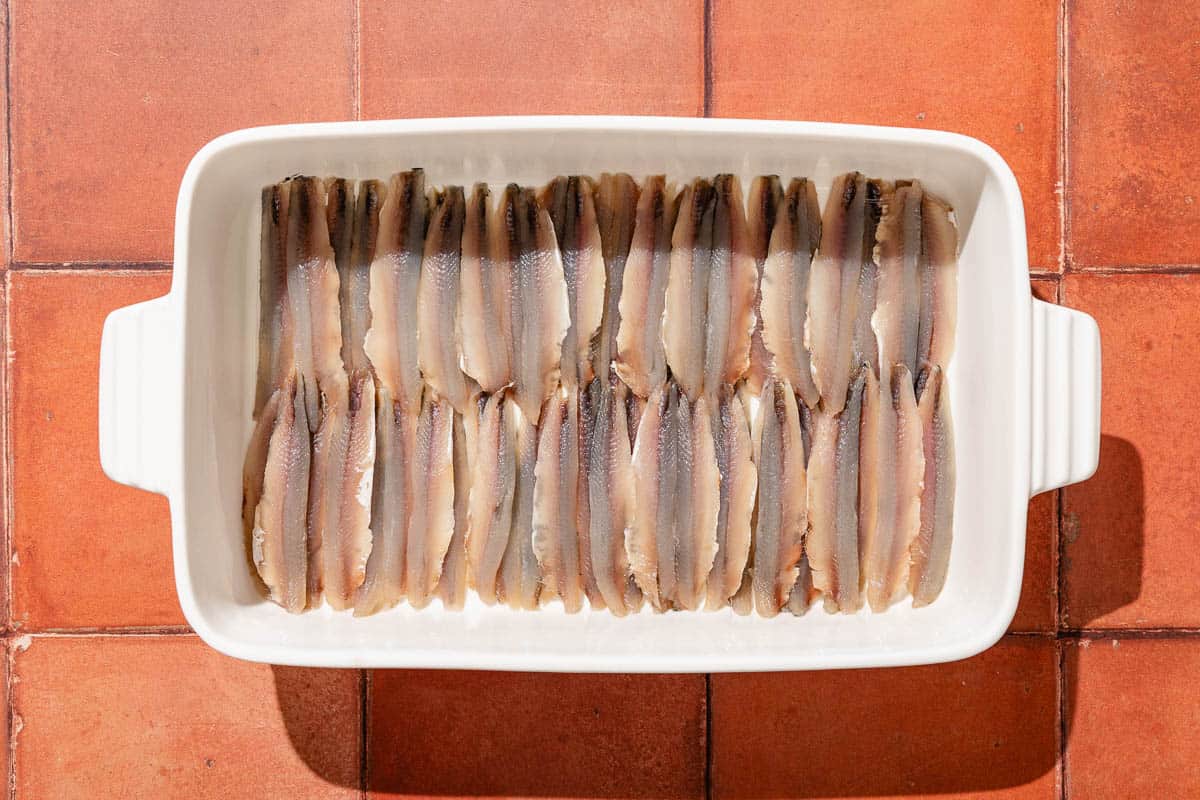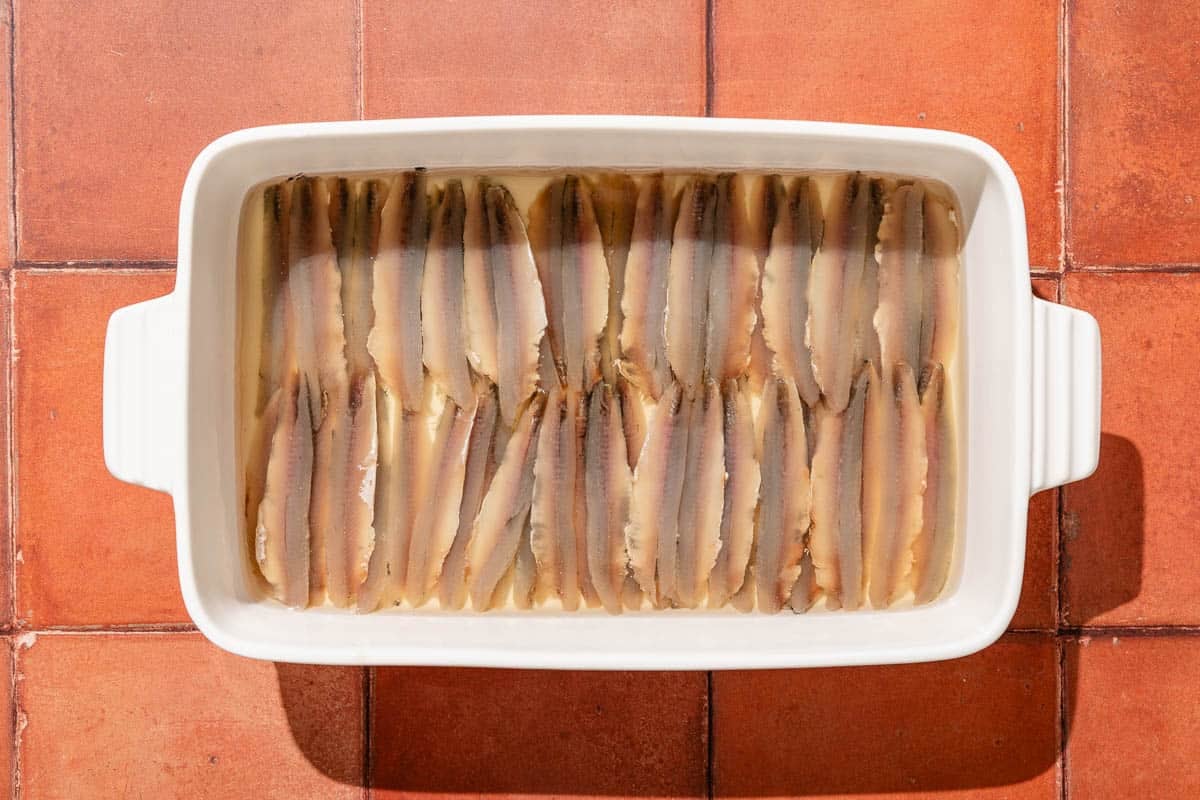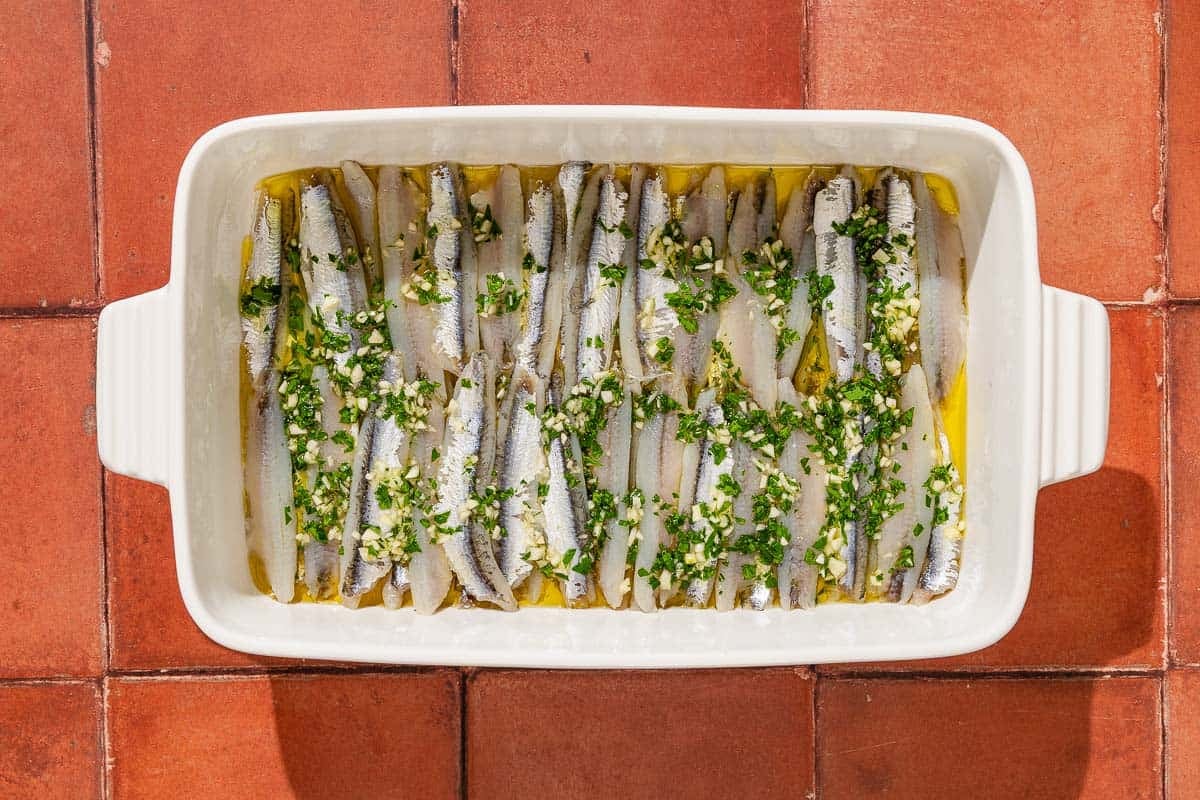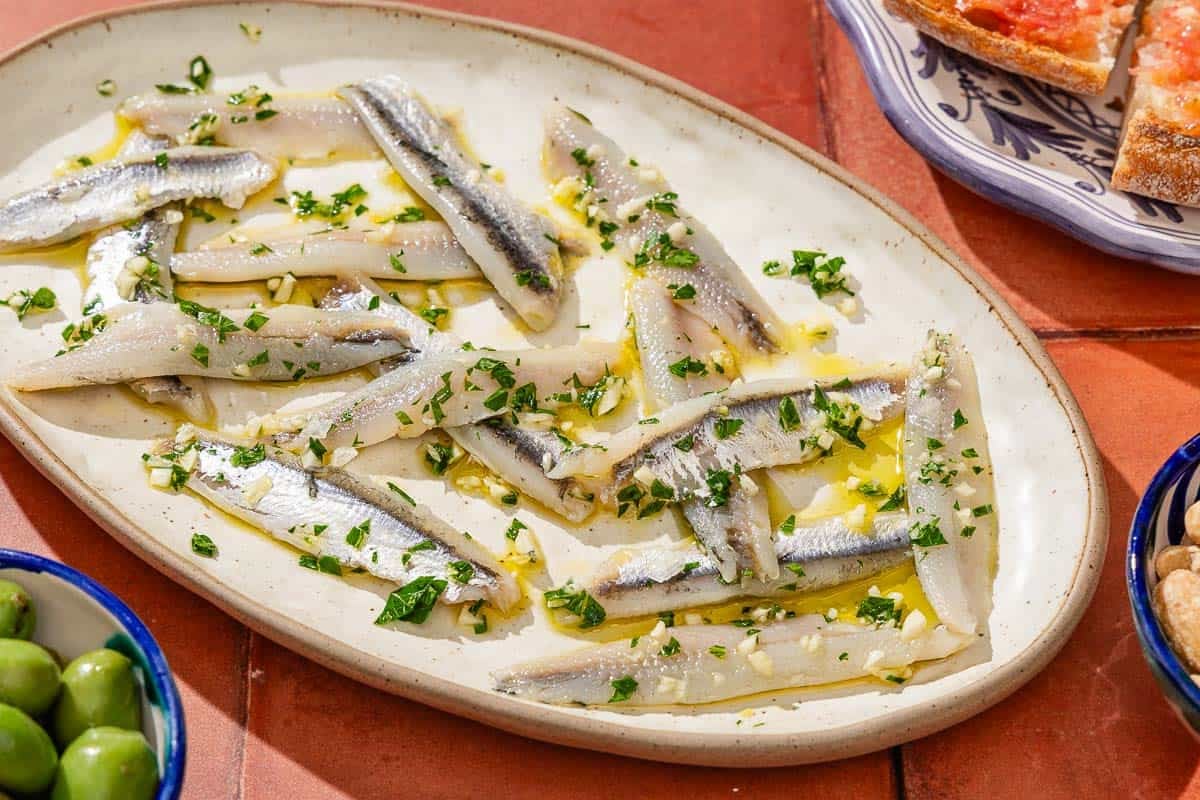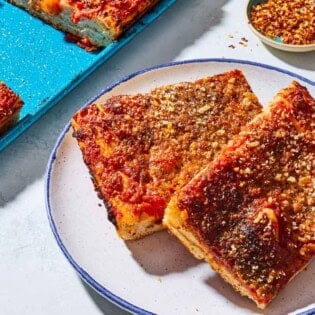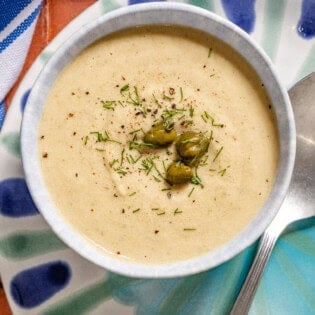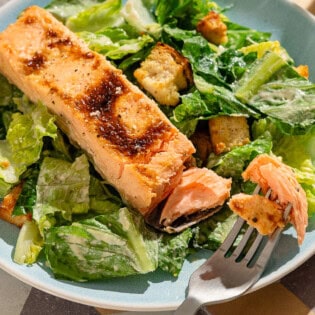Bright, briny, and deeply Mediterranean, Boquerones en Vinagre are a must-try Spanish tapa. These marinated anchovies are pickled until tender and finished with garlic, parsley, and fruity olive oil.
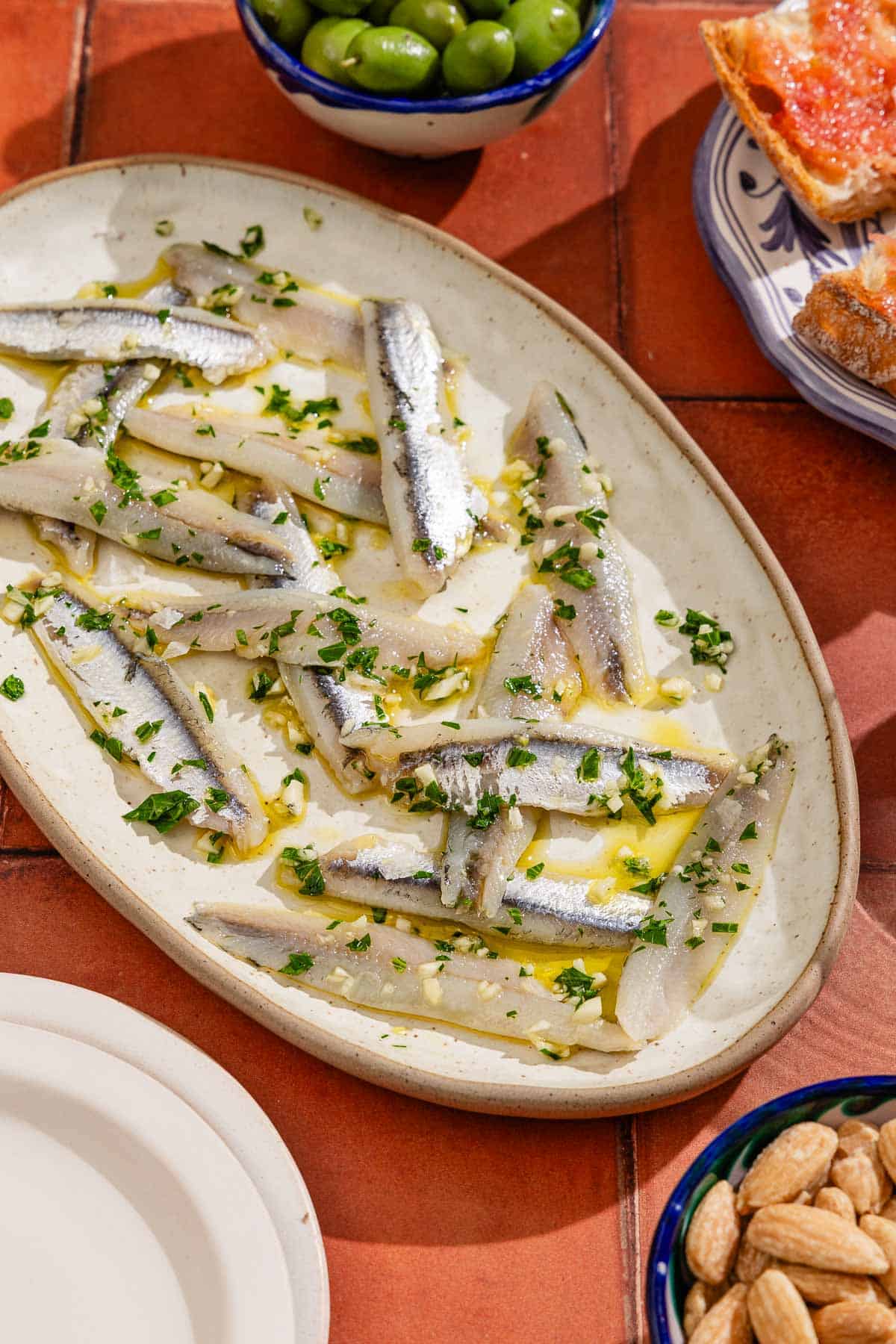
Boquerones, or briny marinated anchovies, are one of my favorite bar snacks in Spain. While many bars have them year-round, they come into season in spring and summer when fresh anchovies are available. And they taste like summer, too: sharp and tangy from the vinegar, infused with garlic and fresh parsley, and with a clean ocean flavor.
While you can get them at the bars, many families also make them at home during the heat of summer, as they don’t require any cooking and can be kept in the fridge for about a week.
Bars typically serve them with a small bowl of potato chips and maybe a mild hot sauce. Stack one on a chip, add a few drops of sauce, and munch away as you sip a glass of vermouth after work. At home, I like to put together some snacks to bring outside into the sun. I serve boquerones on top of some pan con tomate and alongside a bowl of almonds and olives.
Table of Contents
What Are Boquerones?
Boquerones are fresh anchovy filets, and boquerones en vinagre are anchovies pickled in white wine vinegar and then marinated in olive oil, garlic, and parsley. They’re served in classic tapas bars with beer, vermouth, or wine. They’re often on display in an antique terracotta dish behind the bar, ready to be served with potato chips or pan con tomate when you order a drink.
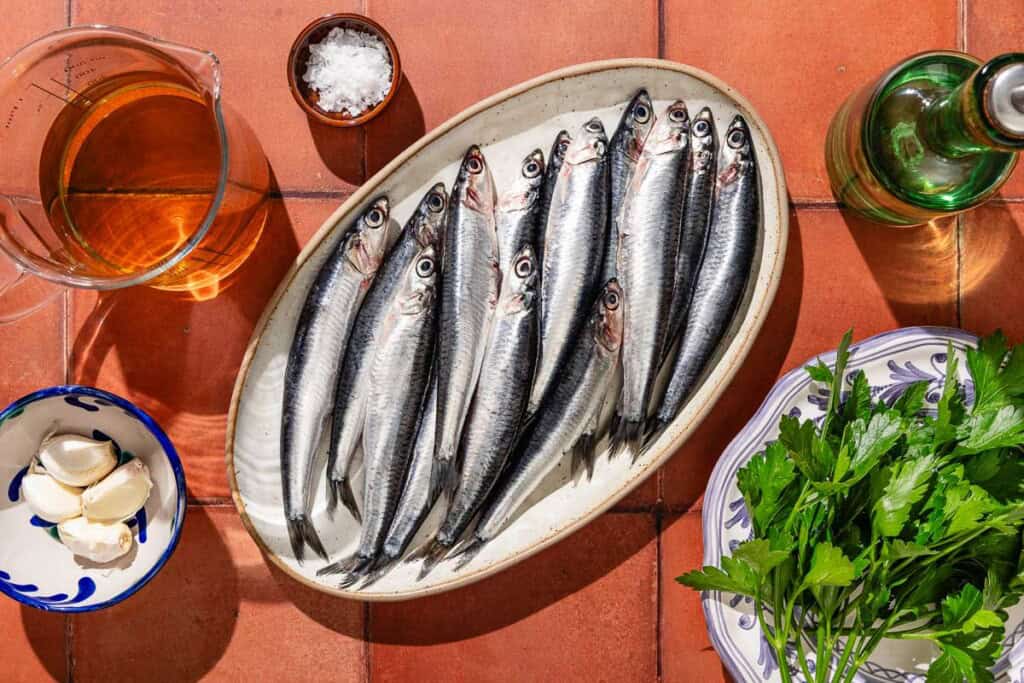
Ingredients for Boquerones en Vinagre
You don’t need much to make marinated anchovies, so the foundation for the most flavorful boquerones is to buy the freshest available fish and use them as soon as possible after purchasing. Here’s what you’ll need:
- Anchovies: Choose the freshest anchovies you can find. Look for bright eyes and shiny, shimmery skin. If you can’t find fresh anchovies, you can use smelts or frozen anchovies. For frozen anchovies, thaw them overnight in the refrigerator, and skip the step of freezing them in the recipe instructions.
- White wine vinegar is mild and fruity, allowing the subtle flavor of the fresh anchovies to shine through. You can substitute sherry vinegar for a more complex, nutty flavor.
- Extra virgin olive oil adds a fruity flavor and balances the sharpness of the vinegar. Use a mild buttery Arbequina olive oil to highlight the flavor of the fish, or a fruity and peppery olive oil like Hojiblanca.
- Garlic: The garlic in this recipe is raw, so with its pungent flavor, three cloves are enough to infuse the anchovies. I love the flavorful bite of garlic, even when left raw, so I often sneak in more.
- Fresh parsley adds bright green color and bright herbaceous flavor.
- Flaky sea salt: While you can season the anchovies with regular sea salt or kosher salt, I love the pockets of crunch from large, flaky sea salt crystals.
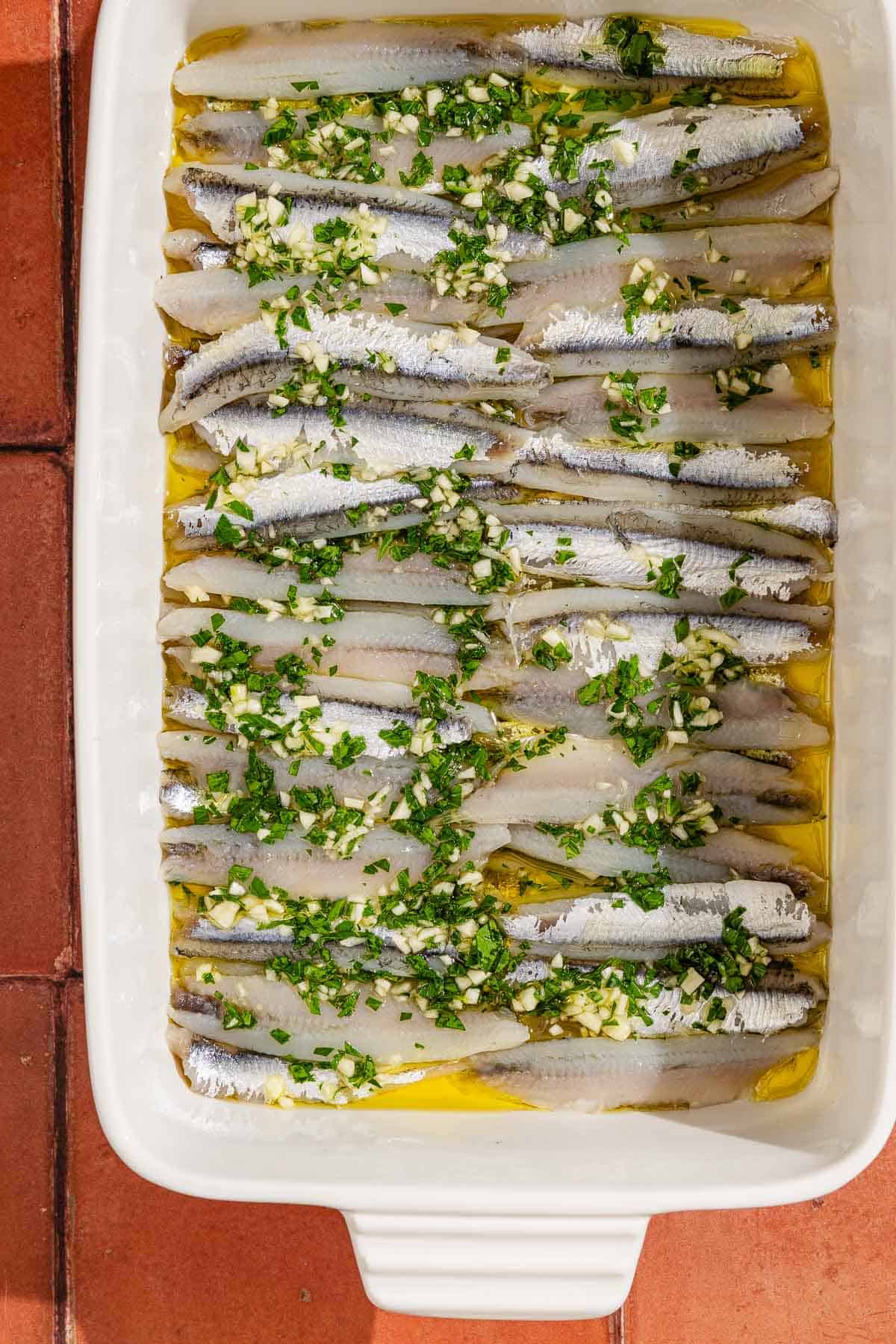
How to Prep Fresh Anchovies
Your fishmonger will likely clean them for you if you ask nicely. But here are all the steps to take them from whole fish to cleaned filets. Anchovies are small, which makes cleaning them easier, but with the caveat that you’ll be cleaning a lot more of them. For ease, I like working on a fish-dedicated cutting board beside the sink. Next to the board, I set up a discard bowl and a bowl to rinse the filets in.
- Scale and gut. The scales on anchovies are generally too small to notice, and the skin is edible. If you do see some large scales, gently scrape them off under cold running water with the spine of a paring knife. To clean an anchovy, hold the anchovy in one hand. With your other hand, pinch the head between your thumb and index finger and pull it down towards the tail, firmly but gently, removing the head and most of the entrails.
- Split. Use a finger or a small paring knife to split the filets along the belly and remove the spine, remaining entrails, and tail. If the fins are noticeable, remove them with a paring knife or kitchen shears. You can leave the filets butterflied or split them. I usually leave them butterflied at this point, so I have fewer individual pieces to clean and split them later when I pickle them. Rinse the anchovy fillets under cold running water to clean them.
- Soak. Letting the anchovies soak further removes blood and any impurities, resulting in cleaner-tasting boquerones with whiter flesh. Fill a large bowl with ice water and add the anchovies. Place the bowl in the fridge and let the anchovies soak for 1 hour. Then drain and rinse the anchovies under cold water.
- Freeze. Dry the anchovies well on paper towels. Place them on a layer of plastic wrap, avoiding overlapping them too much. If you first lay a piece of plastic wrap in between, you can stack a second layer on top. Make sure they’re well wrapped and freeze until completely solid at -4°F for 7 days.
How to Make Boquerones en Vinagre
It’s not difficult to make marinated anchovies, but it does require some time. Plan to account for at least 4 hours to thaw, and another 4 hours to marinate them before serving. Here’s how to make them:
- Defrost the anchovies. Remove 1 pound (454g) cleaned anchovies from the freezer and let them defrost in the fridge the night before or a few hours before you’re ready to pickle them.
- Pickle the anchovies. Mix 1 1/4 cups (300ml) white wine vinegar and 1/2 cup (120ml) cold water in a measuring cup. Place the anchovies into a glass or ceramic tray and pour in the vinegar mixture, ensuring they are completely submerged. Cover and let them pickle in the refrigerator for at least 4 hours and up to 12 hours. The time will depend on the size of the anchovies and your taste preferences. The longer they pickle, the firmer they become, and the vinegar flavor becomes stronger.
- Marinate the anchovies. Remove the anchovies from the fridge, drain the vinegar, and rinse them a few times under cold water to stop the pickling process. Pat the fish dry. Return the anchovies to the cleaned-out tray. Whisk together 4 tablespoons extra virgin olive oil, 3 minced garlic cloves, and 1 tablespoon chopped fresh parsley in a small bowl. Pour the olive oil mixture over the anchovies. Serve them right away, or let them marinate in the oil in the refrigerator for an hour first.
- Finish, serve, and store. When ready to serve, sprinkle the anchovies with flaky sea salt. Eat them as a pincho (small tapa on a toothpick), or serve them on sections of pan con tomate. Submerged in olive oil and covered tightly, marinated anchovies will keep for up to a week in the refrigerator. You may need to pour extra olive oil over the anchovies to submerge them.
Why Freeze Fresh Anchovies?
Anchovies, like sardines, salmon, hake, mackerel, and many other fish, are prone to parasitic infection. Eating raw or undercooked fish infected with these parasites can make you sick.
When serving raw fish dishes like this one, the Centers for Disease Control recommends freezing fresh fish until completely solid for 7 days. If you purchase anchovies for this recipe already frozen, you can skip this step.
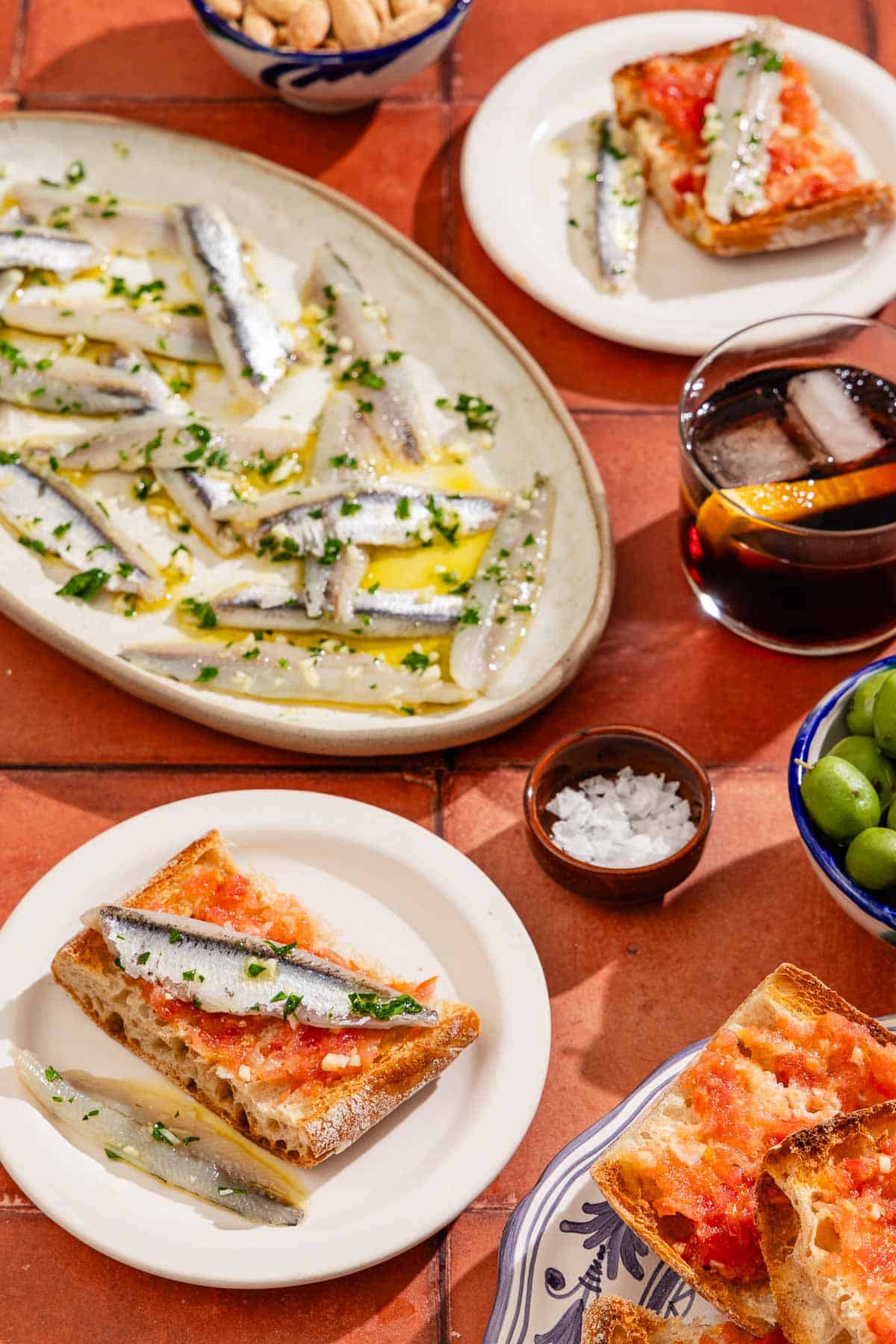
What to Serve with Boquerones en Vinagre
I love to add them as a topping on pan con tomate or even slide them into a sandwich like this focaccia sandwich with roasted red peppers.
For an authentic tapas spread, serve marinated anchovies alongside marinated olives, a refreshing bowl of salmorejo, and spicy patatas bravas. Try a glass of white sangria, or stick with a classic vermouth garnished with a slice of orange and an olive.
More Anchovy Recipes
Dips and Condiments
Tonnato—The Italian Tuna and Caper Sauce You’ll Want on Everything
Salads
Salmon Caesar Salad
Fish and Seafood
Sardine Pasta with Fennel and Saffron (Pasta con le Sarde)
Browse all Mediterranean recipes.
Visit Our Shop.
Boquerones en Vinagre (Marinated Anchovies)

Ingredients
- 1 pound fresh anchovies (454g), cleaned, bones removed, butterflied, and frozen for 7 days (see notes)
- 1 1/4 cups white wine vinegar (300ml)
- 1/2 cup cold water (120ml)
- 4 tablespoons extra virgin olive oil
- 3 garlic cloves, minced
- 1 tablespoon chopped fresh parsley
- Flaky sea salt, to taste
Instructions
- Defrost the anchovies. Remove the anchovies from the freezer and let them defrost in the fridge the night before or a few hours before you're ready to pickle them.
- Pickle the anchovies. Mix the vinegar and water in a measuring cup. Place the anchovies into a glass or ceramic tray and pour in the vinegar mixture, ensuring they are completely submerged. Cover and let them pickle in the refrigerator for at least 4 hours and up to 12 hours. The time will depend on the size of the anchovies and your taste preferences. The longer they pickle, the firmer they become, and the vinegar flavor becomes stronger.
- Marinate the anchovies. Remove the anchovies from the fridge, drain the vinegar, and rinse them a few times under cold water to stop the pickling process. Pat the fish dry. Return the anchovies to the cleaned-out tray. Whisk together the minced garlic, parsley, and olive oil in a small bowl. Pour the olive oil mixture over the anchovies. Serve them right away, or let them marinate in the oil in the refrigerator for an hour first.
- Finish, serve, and store. When ready to serve, sprinkle the anchovies with flaky sea salt. Eat them as a pincho (small tapa on a toothpick), or serve them on some pan con tomate. Submerged in olive oil and covered tightly, marinated anchovies will keep for up to a week in the refrigerator. You may need to pour extra olive oil over the anchovies to submerge them.
Notes
- Shop this recipe: Visit our shop to browse quality Mediterranean ingredients including the olive oil used in this recipe.
- How to Clean Fresh Anchovies:
- Scale and gut. The scales on anchovies are generally too small to notice and the skin is edible. If you do see some large scales, gently scrape them off under cold running water with the spine of a paring knife. To clean an anchovy, hold the anchovy in one hand. With your other hand, pinch the head between your thumb and index finger and pull it down towards the tail, firmly but gently, removing the head and most of the entrails.
-
- Split. Use a finger or a small paring knife to split the filets along the belly and remove the spine, remaining entrails, and tail. If the fins are noticeable you can trim them with a paring knife. You can leave the filets butterflied or split them. I usually leave them butterflied at this point, so I have fewer individual pieces to clean and split them later when I pickle them. Rinse the anchovy filets under cold running water a few times to clean them.
- Soak. Letting the anchovies soak in ice water for an hour further removes blood and any impurities, resulting in cleaner-tasting marinated anchovies with whiter flesh. Fill a large bowl with ice water and add the anchovies. Place the bowl in the fridge and let the anchovies soak for 1 hour. Remove the bowl from the fridge, drain, and rinse the anchovies a few more times under cold water.
- Freeze. Dry the fish well on paper towels. Place the anchovies on a layer of plastic wrap, avoiding overlapping them too much. If you first lay a piece of plastic wrap in between, you can stack a second layer on top. Make sure they’re well wrapped and freeze them until completely solid at -4°F for 7 days.
- Why Freeze Fresh Anchovies? Anchovies and many other fish and shellfish are prone to parasitic infection. Eating raw or undercooked fish can make you sick. When serving raw fish dishes, including this one, the Centers for Disease Control recommends freezing fresh fish until completely solid for 7 days. If you purchase anchovies for this recipe already frozen, you can skip this step.
Nutrition
Bundle and Save!
Four of our best-selling signature olive oils, perfect for everyday use.
